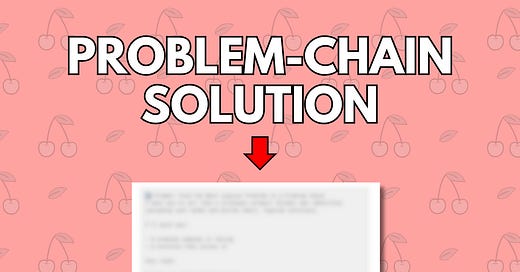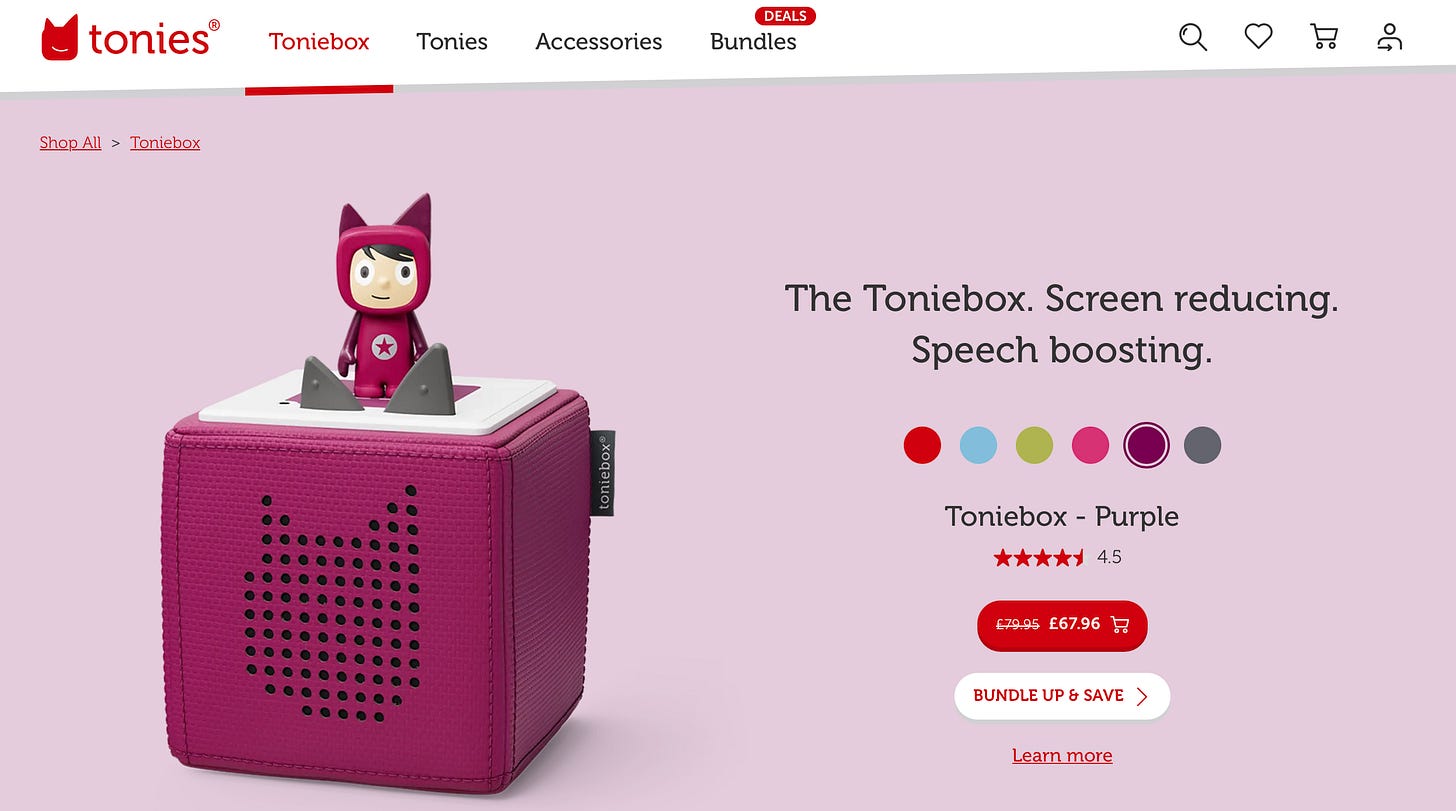Pick Better Problems to Solve with this *Problem-Chain* Framework 🧠
The subtle shift to siesmic change
Hey Part-Time Creator,
Take this newsletter and apply it to your business daily; it’ll help you build your business smarter. This is a paid post. If you’re a busy professional with an ambition to sell a product or service on the internet:
Many subscribers expense this newsletter. It works out at about $0.50 per growth hack.
7.2 billion views
192 million subscribers
🔒 The problem: standing out in a crowded market.
🔑 The solution: the *upstream* proposition.
Here’s how you stand out in a crowded market👇
Solve the *upstream problem* not the obvious problem
When designing a business, it’s easy to see the first problem as the obvious problem to solve, but actually, when you delve deeper, you unlock a business proposition you might not have thought of.
It’s hard to go into without giving you examples…
Here’s how it works:
❌ Solving the presenting problem.
✅ Solving the *upstream* problem
Instead of solving the problem you can see, go for the next one in the line. To do that, you have to understand the market and what’s on offer and present the next thing.
The trick is to not solve a singular, obvious problem— instead, it’s to understand the problem space, understand your potential prospects, and solve the next problem in the list.
But first, you must find problems that have a demand.
Find signals for demand
There is a common misconception that to build something successful, you must invent something entirely new. Most people think that if the market is crowded, they should avoid it.
That’s not the case.
At least not in my opinion; in fact, a market with a lot of noise tells you one thing — there’s demand.
And that’s a huge problem solved. One of the biggest things that kills many businesses is creating great products that nobody wants. Your product can be the best thing in the market, but if the market is made up of a handful of people, you won’t have a thriving business.
Here are some signals for demand:
It happens daily*
It’s a necessity (has to happen)
It’s a problem that’s never going away
*Doesn’t have to be daily, but it helps — a reoccurring problem often has more *pain* associated with it than one that happens only now and again.
Here are some examples…
Cocomelon case study
7.2 billion views
192 million subscribers
Cocomelon is a children’s video company that posts videos of all the old classics — Wheels on the Bus, Peak a Boo, all the good stuff. And just look at those video numbers — 7.3 billion, 7 billion, 4.4 billion, 3.8 billion views— yes, billion.
Why does this work?
Because kids are always going to need entertaining, and parents are always going to need help with that. No matter what your stance on kids and tech is, most parents, at some point, will resort to TV time, and something educational is always going to trump something not.
And what entertains kids over and over again? Nursery rhymes.
❌ Problem: I need some time to do [insert anything], but my child needs entertaining
✅ Solution: Cocomelon
This works because Cocomelon has taken something we used to do ourselves (sing nursery rhymes) and made it:
More accessible — turn it on, and there’s a video with all the words (if you’re anything like me, you often forget).
More entertaining — not only is there audio, but there are animations that keep kids entertained.
More sustainable — get bored after singing Baby Shark for the 17th time? This has got you covered.
Aka, Cocomelon solves an obvious problem in a crowded market but does it better than the competition.
But every solution creates a new problem.*
And this is the absolutely key to the ‘problem-chain’ solution.
Enter — Tonies
With the rise of technology solving the entertainment problem, a new problem is created…
All of a sudden, we’ve got parents worried about their screen time, thinking: “I want to entertain my kids, but I don’t want them stuck in front of the TV the whole time”.
So, Cocomelon solves one problem but inadvertently creates another.
And here’s what it looks like:
❌ Problem: I need some time to do [insert anything], but my child needs entertaining
❌ Problem 2: I don’t want my child to be glued to the computer screen
✅ Solution: Tonies
Tonies is a audio box that when you put certain characters on the top of it, it reads out a story. It’s like Audible for kids with a slight element of gamification.
And this will blow your socks off — Tonies, at the time of writing this, has a market cap of $718 million. Yep, $718 million for essentially a box that reads out children’s stories.
Why does this work?
Because parents are stretched for time but still see the value in the nighttime story. It’s a ritual that is ingrained in us from a young age.
In an era of worried parents who are stretched for time and who want the best for their kids but don’t want them stuck in front of a screen, this is a brilliant option.
So a box that reads out night-time stories is a $700+ million+ business.
Remember, it’s:
Market fit + 10% better = a killer product.
You don’t have to reinvent the world, you just have to be slightly better than your competition.
But as we’ve said, a new solution = a new problem…
Enter a new opportunity
So we’re here.
With kids listening to nighttime stories from a box. There’s no screen time, but it creates another problem for parents.
❌ Problem: I need some time to do [insert anything], but my child needs entertaining
❌ Problem 2: I don’t want my child to be glued to the computer screen
❌ Problem 3: I’m worried my child’s learning is becoming too passive
✅ Solution: A storybook company that helps children make their own stories combining play with audio cues — figurines, story dice etc. < totally made-up company btw.
Remember, every solution creates a new problem.
Your GPT prompt
But let’s say you’re not in the children’s toy business. If you want to solve for the *upstream opportunity* use this prompt below:
🔁 Prompt: Find the Next Logical Problem in a Problem Chain
I want you to act like a strategic product thinker who identifies cascading user needs and builds smart, layered solutions.
I’ll give you:
- A problem someone is facing
- A solution that solves it
Your task:
Explain how this solution works.
- Identify the new problem this solution unintentionally creates (or reveals).
- Suggest a specific example of a product that solves this new problem — if one exists.
Describe the next step in the chain — what’s the next likely challenge?
Format your answer like this:
Initial Problem: [Insert original problem]
Solution: [Product or approach that solves this]
New Problem Created: [What issue does the solution introduce or make visible?]
Why It Matters: [Why users care, what's emotionally or practically at stake]
Product Example (if any): [Optional real-world product that solves it]
Next Challenge (Optional): [Another evolution of the problem]
Here's an example:
Initial Problem: I need some time to do things, but my child needs entertaining.
Solution: Cocomelon (keeps kids happy with engaging videos).
New Problem Created: I don’t want my child to be glued to the screen for hours.
Why It Matters: Parents feel guilty about passive screen time and worry about attention spans.
Product Example: Toniebox (screen-free audio entertainment that kids can control).
Next Challenge: My child is tired of the same stories and wants new ones constantly, but I don’t want to keep buying new Tonies.
---
Use this example and my framework to come up with a problem-chain for my problem.
This is my problem: [INSERT BUSINESS PROBLEM]That’s all for today.
Much love,
Eve
Founder - Part-Time Creator Club







